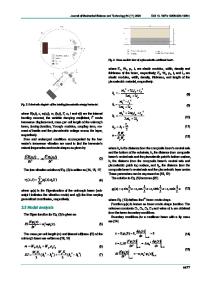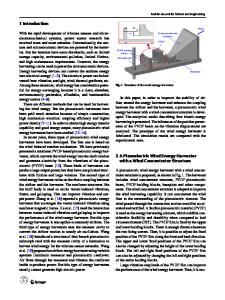Fatigue study and durability improvement of piezoelectric single crystal macro-fiber composite energy harvester
- PDF / 4,165,905 Bytes
- 6 Pages / 595.276 x 790.866 pts Page_size
- 41 Downloads / 320 Views
ORIGINAL ARTICLE
Fatigue study and durability improvement of piezoelectric single crystal macro‑fiber composite energy harvester Jongmoon Jang1 · Geon‑Tae Hwang1 · Yuho Min1 · Jong‑Woo Kim1 · Cheol‑Woo Ahn1 · Jong‑Jin Choi1 · Byung‑Dong Hahn1 · Joon‑Hwan Choi1 · Dong‑Soo Park1 · Yongsuk Jung2 · Woon‑Ha Yoon1 Received: 23 March 2020 / Revised: 19 May 2020 / Accepted: 21 May 2020 © The Korean Ceramic Society 2020
Abstract In the energy harvester, the fatigue caused by cyclic vibration is an important challenge affecting the lifetime of the device. The aim of this study is to evaluate the fatigue behavior of the cantilever-type piezoelectric energy harvester (PEH) based on a single crystal macro-fiber composite (SFC), and propose a method for improving durability. The initial output of the fabricated PEH shows 6 mW root mean square power at 0.5 gravitational acceleration at resonance frequency (23 Hz). In fatigue test under cyclic vibration, the dramatic power decrease and waveform distortion caused by the mechanical crack at the top electrode line were identified after 5 × 106 cycles. To improve the issue, the stress distribution on the top electrode line was analyzed by finite element analysis and the reinforced structure was proposed by attaching a 50 µm-thick polyimide film. The reinforced PEH shows the durable output power until 107 fatigue cycles without a significant output power loss. These study potentially can be applied to the development of reliable SFC-based PEH with long-term lifetime. Keywords Piezoelectric · Energy harvesting · Single crystal macro-fiber composite · Fatigue behavior · Durability
1 Introduction An energy harvester is a device that converts external sources of energy, including vibration, solar, heat, and etc., into electrical energy enabling self-powered system to operate [1]. The vibrational energy harvesters using mechanical energy sources that are relatively easily accessible in daily life have been widely studied, and their key mechanisms include piezoelectric [2–4], triboelectric [5, 6], magnetoelectric effect [7–9]. Among these, the piezoelectric effect has been applied as the energy harvester due to its relatively high output power density, easy of manufacture, structure integrity, and high conversion efficiency [10]. Numerous piezoelectric materials have been applied to piezoelectric energy harvesters (PEHs), including thin/thick ceramic patches, wafers, polymers, macro-fiber composite (MFC), * Woon‑Ha Yoon [email protected] 1
Laboratory for Functional Ceramics, Korea Institute of Materials Science (KIMS), Changwon 51508, South Korea
Optics‑Sensor Team, Hanwha Systems Co., Ltd, Seongnam 13524, South Korea
2
and single crystal macro-fiber composite (SFC) [2, 11]. In particular, MFC and SFC is promising for the PEH application due to their high mechanical flexibility, electromechanical properties, and damage tolerance [12–15]. SFC is also advantageous for developing the high performance PEH because of their high piezoelectric constant and coupling coefficient [16
Data Loading...











